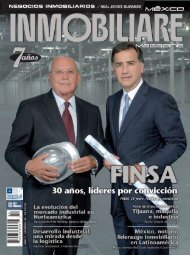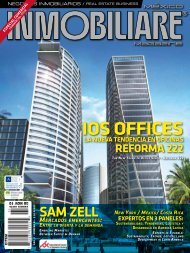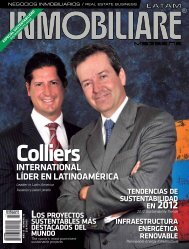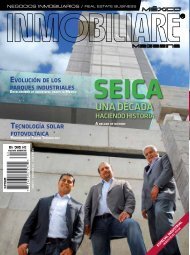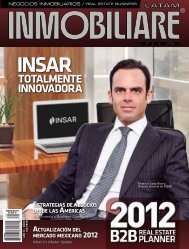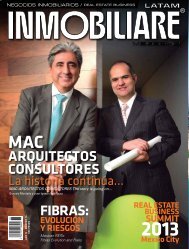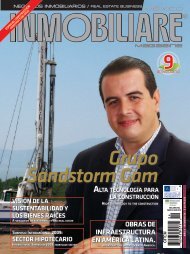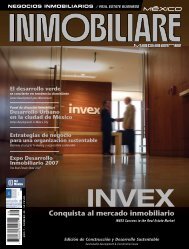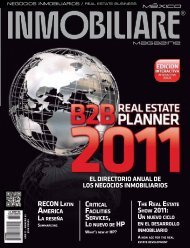Visión, pasión y creatiVidad - Inmobiliare
Visión, pasión y creatiVidad - Inmobiliare
Visión, pasión y creatiVidad - Inmobiliare
You also want an ePaper? Increase the reach of your titles
YUMPU automatically turns print PDFs into web optimized ePapers that Google loves.
eporte softecurbana. Además, concentran una buena partede los proyectos inmobiliarios actualmenteen desarrollo.Concentración dedesarrollos de mayorvalorLos especialistas del World Office Forum, en suencuentro de julio de 2011, preveían que Paseode Reforma se convertiría en el principalcentro corporativo de la Ciudad de México,y para el 2014, anticipaban la construcciónde 13 nuevas torres en estos trece kilómetrosde avenida. Al término del primer trimestrede 2011, Colliers ya censaba 770,000 m 2 deoficinas A+/A y B en Reforma. Polanco por suparte, no se queda atrás con 950,000 m 2 deoficinas. Además, su mercado habitacionales muy dinámico.En julio del 2011, Softec censó once desarrolloshabitacionales en Polanco, todospertenecientes al segmento Residencial Plus;es decir, vivienda para población de alto ingreso,con precios promedios de $33,000pesos por m 2 . En concordancia, Reformatambién alberga desarrollos de viviendade precio alto. Para la misma fecha, Softeccensó nueve proyectos habitacionales en lazona. Seis en el segmento Residencial Plus ydos en el segmento Residencial; el precio porm2 es sensiblemente más alto que en Polanco,con un promedio de $42,500 pesos.Los retos de unadensificación masextendidaCon desarrollos mixtos y verticales, Reformay Polanco, se están consolidando comozonas densas que se caracterizan por estarenfocadas a poblaciones de mayores ingresos.Esto se entiende por el costo de la tierra,debido a que prácticamente estas zonas yaestán completamente urbanizadas, equipadas,además de que históricamente son zonasmuy deseadas.Si la SEDUVI quiere extender estos conceptosde densificación urbana hacia otraszonas de la ciudad, y con este hecho permitirque la población viva más cerca de sutrabajo, tendrá que preocuparse por el costode la tierra y los usos de suelo.In the last event organized by the Real EstateDevelopers Association (ADI for its acronymin Spanish), Ariel Cano, General Director ofCONAVI, stressed the importance of encouragingpublic policies focused on promoting urbanredensification. Likewise, SEDUVI (the Ministryof urban development and housing) wants acompact city that will encourage traveling onfoot and the use of public transportation. Oneof the ways to encourage this urban developmentis by investing in public spaces.Urban redensification andpublic spaceCities’ redensification happens through verticaldevelopments, which need good circulation, bothfluid and mixed, that does not center only aroundautomobiles, but is multimodal (pedestrians,At the Real Estate Development Expo held lastMay, several voices spoke in favor of urban redensification.In order to understand how thisurban model is being implemented in MexicoCity, two of its most important corridors, Reformaand Polanco, are particularly interestingstudy cases.subway, bicycle, bus, etc). Reforma and Polancoare located at the crossing of large roads bothfor individual and public transportation. However,circulation is not optimal. Thus, the sidewalks onReforma Ave. were made wider to make it easierfor pedestrians to walk about.Another project is the transformation ofthe Chapultepec Modal Transportation Center(Cetram for its acronym in Spanish), whose goalis to simplify and encourage multimodal traffic.At the exit from the Chapultepec subwaystation, the project proposes the reorganizationof 130 linear meters of lanes for 600 publictransportation vehicles; there is a plan to builda commercial street, as well as a 70-story officetower, with a shopping center and 2,000parking spaces.Public space is also a concern in Polanco. Forinstance, Grupo Carso plans to develop in “NuevoPolanco” a lineal park spanning eight kilometersof green areas with trees and bike tracks, as wellas broad sidewalks for pedestrians.Mixed-use development inboth areasMixed uses are another characteristic of theprojects that favor urban density, as they makeit possible to reduce people’s travel. In Polancoand Reforma, several of the projects that havebeen developed recently combine housing,shopping spaces, offices, and/or a hotel. Examplesof this are Parques Polanco and PlazaCarso in Polanco; and Reforma 222 and the StRegis Hotel & Residences in Reforma.For this reason, we can say that Polancoand Reforma Ave. show a clear trend towardsurban redensification. In addition, they concentratea large number of the real estate projectsthat are currently under development.Concentration of higher valuedevelopmentsIn their encounter in July 2011, World Office Forumspecialists forecasted Reforma Ave. to becomethe main corporate center of Mexico City,and by 2014, they anticipated the constructionof 13 new towers in these thirteen kilometers ofavenue. At the end of the first quarter of 2011,Colliers had already censused 770,000 m2 ofA+/A and B offices on Reforma. Polanco, on theother hand, is not at all behind, with 950,000m2 of offices. In addition, its housing market ishighly dynamic.In July 2011, Softec took a census of elevenhousing developments in Polanco, all in theResidential Plus segment; that is, housing forhigh-income population, with average pricesper m2 of $33,000 pesos. Likewise, Reformaalso has high-priced housing developments. Inthe same period, Softec took a census of ninehousing projects in the area: six in the ResidentialPlus segment and two in the Residential;the price per m2 is significantly higher than inPolanco, at an average of $42,500 pesos.The challenges of a morewidespread densificationWith mixed and vertical developments, Reformaand Polanco are becoming consolidated asdense areas, characterized by their focus on thehigher income population. This is understandable,due to the cost of land, as these areasare practically all urbanized, equipped, and besides,highly desired historically.If SEDUVI wishes to spread these conceptsof urban densification towards other parts ofthe city, and thus enable the population to livecloser to their jobs, it will have to think aboutthe cost of land and land uses. •44www.inmobiliare.com



